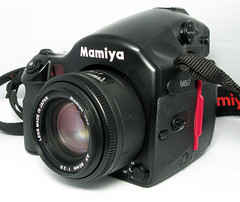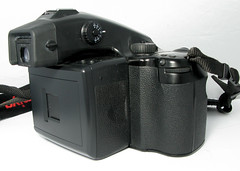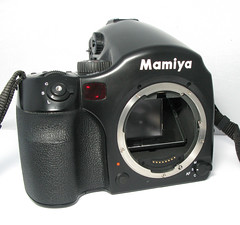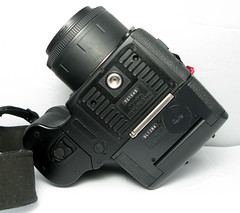Mamiya 645 AF and 645 AFD series

|
| 645 AF image by Rachel Rayns (Image rights) |
The 645 AF is a medium-format SLR camera made in Japan by Mamiya, the company's first autofocus camera. It was released in Japan in September 1999.[1] It was followed in December 2001 by the 645 AFD, a version of the same camera made compatible with some digital backs (not produced by Mamiya at the time), and Mamiya produced improved models, the 645 AFDII and 645 AFDIII later. These retain the ability to use either film or a digital back, switching from one to the other quickly, mid-roll if desired.
The cameras have a new bayonet lens mount incorporating several electrical contacts, to support the use of AF lenses. However, this is compatible, in a limited way, with the lenses for the preceding models (the Mamiya M645 and M645 Super series cameras). The manual-focus lenses can be fitted to the new mount, but the cameras do not have the pin to mate with the aperture yoke on these lenses, so stopped-down metering must be used. There is also a special focusing screen, with a manual-focusing aid (a microprism/rangefinder spot) for use with manual lenses.
645 AF
|
| ||||
|
| ||||
|
| ||||
Many of the features of the 645 AF are retained from Mamiya's previous series of 4.5x6cm SLR cameras /(the M645 Super and related models). However, the camera is not built in the modular way that those cameras were; the power film winder is built-in, as is the prism viewfinder; a waist-level finder cannot be used (although there is a right-angle eyepiece attachment).
As in previous camera series, the prism finder has settings for spot (S) or centre-weighted average (A) metering, and a setting (A-S) in which the camera automatically selects one or other of these, based on the variation in brightness in the scene. The meter allows exposure compensation by up to three stops in either direction. The viewfinder eyepiece has a shutter to keep out light when the camera is used away from the eye, and built-in diotric adjustment.
The camera is controlled via menu options displayed in an LCD on top of the winder grip, and selected with a wheel control by the shutter release button, in combination with a mode dial. The mode dial has settings for metered manual exposure control (M), shutter-speed priority AE (Tv), aperture-priority AE (Av), programmed AE (P), auto flash (X) and a setting for long exposures (T). The shutter release button has settings for single or continuous exposures, and a locked position. It is threaded for a standard cable release.
There is a hot shoe on top of the prism, as well as a PC socket on the left side. The camera was compatible with some Metz flashes for through-the-lens flash metering, with an adapter.
The 120 film back for the 645 AF is superficially similar to that for the earlier M645 Super, but has an LCD to set and display the film speed, and requires its own battery to support this. It also has more electrical contacts than the earlier film back, and the two are not interchangeable. The same back accepts both 120 and 220 film inserts. There is also a Polaroid back.
There is a mirror-up lever on the left-hand side of the body.
The camera requires six AA batteries, which are loaded in the grip.
645 AFD

|
| 645 AFD image by Tony Roman (Image rights) |
Notes
- ↑ Mamiya company history, in Japanese, on the Mamiya Digital Imaging website.





